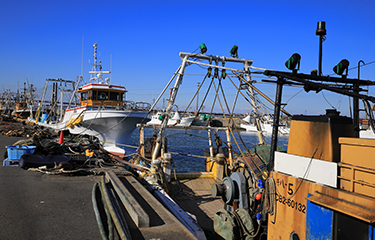Japan’s top fishing port feeling effects of rising sea surface temperatures

The morning of 9 March, an unusual event occurred at the Choshi City Fishery Cooperative Association’s No. 2 Wholesale Market, located in Japan’s Chiba Prefecture.
A vessel unloaded its hold of largehead hairtail (Trichiurus lepturus, or tachiuo in Japanese), filling several trucks that would carry the catch to local processors. The warmwater fish, which are also sometimes called “scabbardfish,” are most common in the Seto Inland Sea to the south. They can also be caught in Tokyo Bay, but are abnormally plentiful off Choshi this year.
Conversely, Pacific saury, which prefer cold water, were completely absent in Choshi for the first time on record last year. Japan’s annual saury catch has been in decline since it peaked at 61,333 metric tons (MT) in 2009. It fell to consecutive record lows for three years in a row, to 29,566 MT in 2020, 18,291 MT in 2021, and 17,910 MT in 2022. While overfishing by factory vessels from China and Taiwan are partly to blame, changes in water temperature and ocean currents are also keeping the fish longer in international waters northeast of Hokkaido, the country’s northernmost prefecture.
Also on 9 March, over at the No. 3 wholesale market, where the morning’s catch had already been sold, the trays and buckets of fish were being sorted and prepared for buyer pickup. The No. 3 market is for higher-value fish that are sorted and treated individually, such as splendid alfonsino (kinmedai in Japanese, a local specialty), flounder (hirame), and red gunnard (hobou).
A friendly worker dragged over a tray of smallish fish – probably too small to find a buyer – and started rattling off the different species.
“Takanohodai, kasago, ishidai, higesori, kawahagi, nametagare – and this one I don’t know, but they started showing up here recently,” he said. “We think they’re usually found farther south, but we’re getting a lot of them lately. They’re a bit of a nuisance, since people are hesitant to eat an unfamiliar fish.”
Those fish are, in English and Latin, the spottedtail morwog (Cheilodactylus zonatus), false kelpfish (Sebastiscus marmoratus), striped beakfish (Oplegnathus fasciatus), short barbeled velvetchin (Hapalogenys nigripinnis), thread-sail filefish (Stephanolepis cirrhifer), and slime flounder (Microstomus achne).
As for the new arrival, a search through Fishbase revealed it to be a higedai (long barbeled grunter, or Hapalogenys sennin). The species was previously spotted by scuba divers off Miyazaki in Kyushu, but more recently extended its range north to Shizuoka and the Izu Peninsula. Now that range reaches the Boso Peninsula, which makes up most of Chiba Prefecture.
Warmer sea surface temperatures are the leading culprit for the changes in catch ...
Photo courtesy of Shii3/Shutterstock





Share